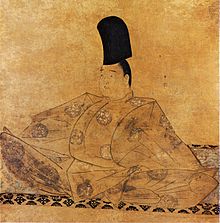| Go-Toba |
|---|
|
 |
| Reign | 1183-1198 |
|---|
| Predecessor | Antoku |
|---|
| Successor | Tsuchimikado |
|---|
| Born | 6 August 1180
Heian Kyō |
|---|
| Died | 28 March 1239
Oki Island |
|---|
| Burial | Ōhara no Misasagi (大原陵) (Kyoto) |
|---|
| Father | Takakura |
|---|
Emperor Go-Toba (後鳥羽天皇, Go-Toba-tennō, 6 August 1180-28 March 1239) was the 82nd emperor of Japan, according to the traditional order of succession.[1] His reign started in 1183 and ended in 1198.[2]
This 12th century sovereign was named after Emperor Toba and go- (後) means "later". He is sometimes called the later Emperor Toba. In some older sources, this emperor may be identified as "Toba the Second" or as "Toba II".
Traditional history
Before he became the monarch, his personal name (imina) was Takahira-shinnō (尊成親王),[3] or Takanari-shinnō[4]
He was the fourth son of Emperor Takakura.[4]
Events of Go-Toba's life
Go-Toba was placed on the throne at the age of three.
- 8 September 1183 (Juei 2, 20th day of the 8th month): In the 3rd year of Antoku-tennō 's reign, the emperor and his court fled the capital. In the emperor's absence, former-Emperor Go-Shirakawa made Antoku's younger brother emperor by decree. A ceremony which marked the young prince's acceptance of the abdication (juzen).[5]
- 1184' (Juei 3): Emperor Go-Toba is said to have accepted the monarch's role and duties and powers (sokui).[4] This was confirmed in ceremonies.[6]
- 1192 (Kenkyū 3): Go-Shirakawa died.[7] Go-Toba was the grandson of Emperor Go-Shirakawa.
- 1198 (Kenkyū 9): In the 15th year of Go-Toba's reign, he abdicated. His successor was his eldest son who became known as Emperor Tsuchimikado.[8]
- 1210 (Jōgen 4): Go-Toba's 3rd son was named emperor; and he became known as Emperor Juntoku.[9]
- 1221 (Jōkyū 3): Go-Toba and his supporters tried and failed to take power from the Kamakura shogunate. This was known as the Jōkyū War (Jōkyū no hen)[10] Go-Toba was exiled to the Oki Islands where he stayed until his death.[11]
- 13 May 1221 (Jōkyū 3, 20th day of the 4th month): Go-Toba's 4-year-old grandson was made emperor; and he became known as Emperor Chūkyō.[12]
- 14 January 1222 (Jōkyū 3, 1st day of the 12th month): Go-Toba's nephew was made emperor; and he became known as Emperor Go-Horikawa.[13]
- 1239 (En'ō 1, 2nd month): Go-Toba died at age 60.[14]
After his death
Go-Toba was buried on Dōgo Island in the Oki Islands group. Later a part of his body was re-buried in Kyoto.[15]
According to the Imperial Household Agency, the mausoleum (misasagi) of Go-Toba is in Kyoto. The emperor is traditionally venerated at a memorial Shinto shrine at Ōhara no Misasagi.[1]
Eras of Go-Toba's reign
The years of Go-Toba's reign are marked by more than one era name:.[2]
